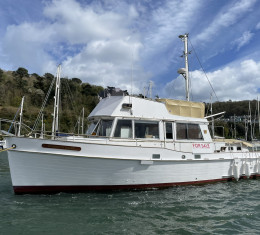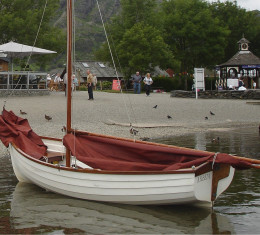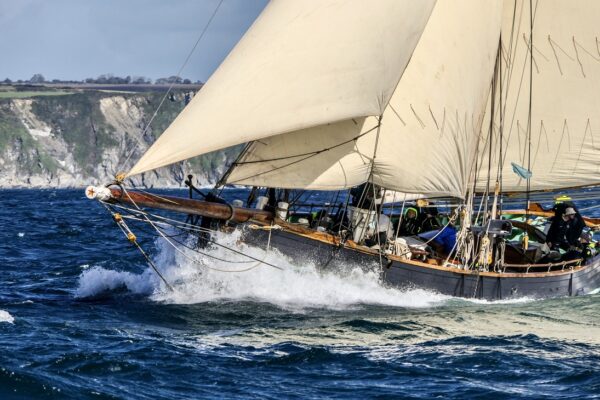Perfect or project?
Perfect boat or project boat
In these financially restricted times we are noting an interest in projects. The problem is that projects vary hugely in type, size and quality and one man’s viable project is another man’s firewood.
The moral must be, know your skills, admit your limitations and make sure everyone is on side because this might take some time.
I have seen some very successful projects and some disasters and it is always the disasters which make better reading of course. However I am not going to write about those because they are invariably exaggerated, always depressing and we don’t like failure here. Failed owners too often blame the boat and not themselves and “I told you so” gets nobody anywhere. Full marks for trying I say but let’s make sure you set off on a course with some reasonable hope for success.
I have just had an e-mail from a brave and determined lady who some years ago set out on a missionary voyage with a group of like-minded people in a little 65’ schooner and by strange circumstances – they would never believe you if you made it up – she became the owner. With age not on her side, no knowledge of wooden boats, not a sailor and no money it looked like only a question of time before it all fell apart.
She thinks it was God at the helm. I am not so sure of His track record as a ship-mate and prefer to think it is her own determination; whichever you care to believe the result has been very encouraging and she is at sea once more with a missionary purpose again. We can only admire such dedication.
A small refit job started here recently when a Suffolk based gent bought a fine Folk Boat.
His first boat was a sailing dinghy before he was captivated by a huge lump of a French-built sailing fishing boat which had been through our hands several times and had absorbed several fortunes over the past 25 years.
Love has no bounds and he dedicated several years of his life to this fine ship but however many flares he fired she was taking him down. With a little encouragement and after a brave rear-guard action he finally accepted the inevitable and we got him out of the big boat and into something far more realistic, a Folkboat.
I have a personal mantra that most people are over-boated and the Folkboat was and still can be the answer to a problem. The original Folkboat was an inspired design and perfect for post war, budget sailing in the Baltic. However it all went wrong when owners wanted to make the design do more than was ever intended.
Being also a popular class here in UK, we persuaded the Norwegians to let us have an English version which meant a bigger coach-roof to get more volume below because we were not as hardy as the Scandinavians and carvel construction to placate market opinion.
Then the Poles and the Hungarians and the East Germans shrewdly spied a gap in the market, enlarged the coach-roof into a block of Soviet flats and turned them out for the cost of a few pints for a thirsty UK market. They were well built, great skill but sadly the mahogany and fastenings used seldom stand the test of time.
A half-way design between the basic Scandinavian FB and the Soviet block of flats came with the few boats built by Cyril White in Brightlingsea in the 1960’s.
He even built a matching pair for the Guiness brothers in 1965.
His success was in keeping the clinker construction which is quicker and cheaper to build and emphasises the very sweet lines of the hull, extending the cock-pit by a few inches on the basis that a lot of small boat sailing is day sailing with a group of friends when extra cock-pit space is desirable and building a coach-roof which is similar to the very small Scandinavian slice of cheese but slightly bigger all round and gaining height by the clever deception of keeping the coamings low and adding camber to the roof.
The result is one single long cabin with no silly internal subdivisions, still 4 berths, 2 in line each side, good sitting head-room, the standard proven FB rig but with an inboard engine.
This is the perfect compromise in a small boat.
If you want a heads or can’t take your socks off in company or God forbid want more than tea and hot soup on a passage then either stay at home and sail virtually or work overtime and buy a bigger boat.
We sold this boat to a chap who never came back to pick her up from the yard so that eventually she was seized and sold for not a lot. However as a repeat warning to all would-be project builders there is no such thing as a bargain. One man’s bargain is the next man’s hole in the water to fill with money and despite appearances this one is more than just a fresh coat of paint if he is going to be serious about taking the opportunity to put her properly right while he is at it.
Projects can be immensely satisfying and rewarding but you have to be realistic. There’s nought for nought in this world. You need money or skill or effort or preferably all 3 unless, like my schooner-owner lady, God and luck are on your side and I don’t see much of either these days.
My Suffolk owner had learnt a lot from his time with the big French boat and sensibly took his new acquisition to a Devon based Scottish boat builder who like many individual, self-employed boat-builders does excellent work at realistic cost.
His recent excavation of the back-bone bolts and chain plate bolts is a lesson to all of us.
The yacht looked perfect a few years ago and indeed was very smart and much cared for. A few years of neglect did her no favours but nothing serious as she has been out of the water and largely covered so the buried deterioration in the bolts must be long standing.
The real horror is the totally predictable and avoidable one of using threaded stainless steel rod as a through bolt. Firstly it is almost certainly stock threaded bar as provided by the builder’s merchant and secondly you never, never bury thread in the timber as Small Cavity Corrosion is inevitable. The right sort of fastenings can all be had and are not even expensive. Suppliers can be found on our Services Section or by a quick call to the office.
People worry about rot in wooden boats but it is our experience that it is more often the metal that goes wrong first and takes the wood with it.
Checking and replacing center-line bolts, keel bolts, chain plate bolts, sea-cock bolts and even hood end fastenings is so easy and inexpensive and can save huge expense and heart-ache later if done in time.
The photos on Charlie Hussey’s web site (https://picasaweb.google.com/charlie.hussey/ShotleyRose?authkey=Gv1sRgCJjYlOzS6ILsXA&feat=content_notification#5845976411878907042) of the fastenings extracted from the Folkboat say it all and confirm that so many issues with wooden boats are not caused by deterioration of wood but by deterioration of the metal which then takes the wood with it.
I had an example of the same problem recently in my pre-war Vertue Caupona. I have sold her several times over the past 30 years and every time I had noted the open stem scarph just below the wl. Repeated surveyors all advised simply filling it and it was never my position to question an expert but when it came to getting my feet wet I was not totally happy. I found a 5/8” bronze bolt through the scarph and several ½” bronze bolts all down the stem holding the inner and outer stem together, all standard stuff.
The 5/8” nut disintegrated when I put a spanner on it and when knocked out, three separate bits of bronze fell to the floor. Bronze or not, it had disintegrated years ago and the stem was held together by habit. Given how people are prone to winding up their rigging, it is amazing how strong habits can be.
Of course the other bonze through bolts all came out, all more or less rotten and were replaced by bronze bolts off the shelf from Seaware in Falmouth at nominal cost and with only a few hours work.
The moral is that not even the best marine quality bronze is proof against the ravages of time and sea water. Fastenings hold a wooden boat together and replacing fastenings can often be a simple Meccano job so don’t hesitate too long to have a look.
I found a similar surprise when I came to replacing some planks on my Miller Fifer. Jimmy Miller was a prolific boat builder but being not just a canny Scot but a Fifer to boot he was not a man to waste money on fancy stuff. So he fastened his Fifer range of motor sailers with galvanised boat nails or cut nails or rose head nails, however you want to call them.
They were good enough for his boys to go to sea fishing in the winter Icelandic waters so they would be good enough for a mere yachtsman and so they have proved to be.
His larch planking used below the waterline is perfect and gives no trouble but I don’t know where he bought his mahogany for the topsides planking and the superstructure.
Even if you can keep the fresh water out of the superstructure by meticulous varnishing, the topsides planking seems to have rotted down the middle of the plank. It is almost as if the wood had some prior fungus from the start which does happen. Having sailed the boat in total confidence and with not a hint of trouble in some weather and some distance before starting on the refit, I told Richard to hit her hard with a ball pein hammer down the length of every plank.
And sure enough all down the water-line plank stbd side the hammer went right through. A tap or a prick on the outside would never have told you that the plank had a fungal rot down the middle.
Replacing planks is the most fundamental part of a refit and also the easiest and should not be expensive. Luke Powell could plank a 40 footer from scratch in just a few weeks and that was using 1.5” thick larch so don’t be fooled by costly plank repairs.
The old planking came out with a chain saw in a few minutes leaving behind the galvanised boat nails in the 4” square sawn oak frames which resolutely refused to move. It took a 3’ jemmy with a 4’ scaffold pole slipped over it to get them to break free. Of the 60 or 70 nails removed only some 5 or 6 did not come out. They were the few which were rusty because water had got in behind and simply snapped at the interface when under stress from the jemmy. That is always a nuisance because the stub then has to be drilled out and the resulting hole plugged before you can go on with setting the new plank.
Last year a chum with an extremely beautiful, teak pre-war Dallimore lost his mast when a bronze chain plate failed. It looked perfect above and below deck but fractured within the thickness of the deck. Sad, dramatic but remember it had been there untouched for 80 years!
And another chum here in Dartmouth lost his mast when his galvanised iron chain plate fractured. The bit of metal above the hole simply pulled out leaving a fork instead of a hole. And again his chain plate had been there untouched for 55 years.
What do we expect – miracles? You can’t just blame this sort of thing on wooden boats. Knowing it’s proclivity to stress fracture, I wonder what all the stainless steel in the modern grp yacht will be like in 50 years?
The moral of this tedious tale – dockside gossip that bronze is fool proof and iron is bad news is not always to be believed and like all gossip it depends on who you are talking to.
It also dictates that maintenance is more than just varnish. If you are going to sail an old boat for £20,000 instead of building a new one for £120,000 then you must carry out some fundamental checks every few years which are more than cosmetic. However they need not be expensive and most can be tackled by a careful owner with a box of simple tools and perhaps just a little advice and encouragement. Don’t think of it as a project, just as a challenge.
The joy of it is that a wooden boat is made up of a large number of small bits and within reason each bit can be replaced in turn while our friends with white plastic can do little when their boats start to go wrong. Of course like modern motor cars the modern yacht relies on being out of fashion long before it wears out so the problem never arises with anyone who is likely to make a fuss.
The real issue yet to be tackled is what on earth do you do with the white plastic blob when it goes wrong and you don’t want it any more?
But that is a delicate subject for another day……………….
Wooden Ships classic yachts brokers have an extensive database of boats for sale. With a wide range of sailboats, classic yachts, motor yachts and small classic boats, Wooden Ships has one of the largest selections of traditional wooden boats and yachts for sale in the UK. For more information about anything on our site please do ask us














